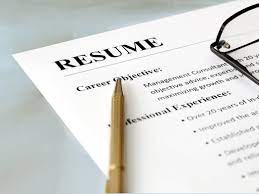The difference between getting your ideal job and getting Choice D is usually a concise résumé. If your resume is concise, every company you apply to will respond. However, if your resume isn’t strong, you can wait weeks or even months without hearing back from potential employers. You may be wondering how you may improve your resume writing skills so that human resources professionals continually contact you for interviews. You’re in the correct place, then!. In this article we will discuss how to create a resume cover letter, with no experience, on an iphone and google docs.
What Is a Resume?
A resume is a document that is typically used when applying for a job. Your resume is a marketing document that summarizes your experience and skills to potential employers in an organized and straightforward fashion. The point is to swiftly convey why, with your specific set of talents and experiences, you are the best candidate for the job.
Furthermore, to create a resume that stands out to hiring managers is as easy as following a few tips and best practices. The primary objective is to make your resume informative and easy to read. Let’s examine in greater detail the optimal approaches for creating these various parts of a resume. Reviewing resume samples from your field and position is a great way to get ideas for your own document.
Why a Resume Is Necessary
Your resume is the single most crucial thing you send out while applying for jobs. It’s your first line of defense, so to speak, when competing for a job, as it serves as an introduction to a possible employer. The average time spent reviewing a CV by a hiring manager or recruiter is just six or seven seconds, so it’s crucial that you make the most of that time. If your resume is inadequate, you may not even be considered for the position you want.
Professionally created resumes can increase your earnings potential by 7%, according to research conducted by Zippia.
What Are the Most Common Types of Resumes?
There are three standard resume formats to choose from: chronological, functional, and combined. Think about your work experience and the nature of the position you’re looking for when deciding on a resume format. To highlight your skills and qualifications rather than your employment history, you might use a functional resume, which is an alternative to the more traditional chronological resume.
#1. Chronological Resume
By definition, a chronological resume will list your work history in reverse chronological order, with your most recent job or positions appearing first. This is the classic resume layout, and it was widely used for years.
The following items frequently appear in this sequence in a chronological resume format:
- Contact information
- Objective or summary statement
- Compelling abilities
- Professional experience
- Education
- Extras (such hobbies and interests) are always welcome.
If you have been steadily climbing the corporate ladder throughout your work history, a chronological resume may be the best format for you to use. If you’ve spent the last few decades working in the same field, with progressively more responsible positions, a chronological resume structure might be the best choice for you. It’s also common among job-seekers whose previous experience lies within the same or a closely related field.
However, you may want to think about a functional or hybrid resume if you have significant gaps in your employment history, are looking to switch careers, or have extensive non-traditional work experience.
#2. Functional Resume
With a functional resume, you highlight your skills rather than your employment experience. In contrast to the chronological format’s emphasis on work history with summaries of achievements at each post, the functional format’s emphasis is on the applicant’s skill set as it relates to the open position.
Typically, the following details appear in this order on a functional resume:
- Contact information
- Objective or summary statement
- Summary of relevant skills
- Work experience
- Education
- Extras (such hobbies and interests) are always welcome.
A functional resume is a good option if you are a first-time employee, are changing careers significantly, have a significant employment gap within the past five years, or have other unusual circumstances. The correct qualifications for the position you want can be emphasized by putting an emphasis on transferable talents and your most relevant achievements. The recruiter can focus less on a work history that is irrelevant to the position and more on the information that is most relevant to the position thanks to this.
In some cases, a strictly functional resume could be too niche for certain job seekers. A hybrid resume can be useful if you have a mixed work history but few or no significant gaps.
#3. Combination Resume
Combination resumes combine elements of both chronological and functional formats. You may highlight both your professional experience and your relevant abilities using this resume format. The bulk of your resume will be taken up by your expertise and work experience; therefore, you may have to cut out extraneous information like a summary statement, volunteer experience, or interests.
The following items frequently appear in this sequence in a combination resume format:
- Contact information
- Summary or objective statement
- Concise overview of most valuable skills
- Career Background
- Education
Because of the adaptability of the combination resume style, you can prioritize the presentation of your abilities or your job history, whichever you feel is more relevant to the position at hand. Put your skills at the top of your resume instead of your employment history if they are particularly relevant to the field in which you are applying. It’s also a good idea to read between the lines of the job description for hints about what the company values most in a candidate.
However, if you’re making a little shift in your field of expertise, or if your work experience is so diverse that its relevance to the position you’re applying for might not be obvious, a combination resume might be your best bet. If you’re applying for a people manager role but don’t have a formal “manager” job title, you can highlight your expertise leading groups by include it in your combination resume. The above format might help you highlight your leadership experience and abilities.
What Makes These Resume Types Exceptional?
Although certain applicant tracking systems (ATS) may have trouble reading a functional resume, these three forms are among the finest possibilities because they are straightforward to read and processed by an ATS without serious errors.
In order to fill a single position, recruiters must often go through dozens of applications. A uniform structure makes it easier for them to find the specific pieces of information they need in a resume. A recruiter will check for keywords in your talent area, which can be found either before or after your job experience, if you have them and if the role demands them. They have a finite amount of time to devote to each resume, so if it takes too long to uncover the proper information, they may go on to the next candidate and presume they are more eligible. Also, read What to Put on a Resume: 10+ Free Tips to Include in a Good Resume.
How To Create a Resume
Although it may be challenging to highlight all of your accomplishments and skills on a single page, there are several strategies to make your resume stand out without being overbearing. Here are some effective tips on how to create a resume.
#1. Resumes Should Be Concise and Straight
First and foremost, when you want to create a resume, you should avoid waffling and get right to the point. Limit yourself to one page unless you have substantial expertise or a long professional history that is relevant to the position you’re applying for.
You can easily shorten your resume by simply including the most relevant and recent work experience. While the lessons you learned in your first year on the job may be invaluable, it’s not necessarily important to list every job you’ve ever had.
Although if you’re just starting out in the workforce, you can shorten this time limit, most experts advice including just employment within the past 10 or 15 years. Including too many irrelevant jobs can make your resume look busy and detract from your strongest points. Your resume needs to stand out by being clear, concise, and targeted.
#2. Create a Unique Format for Your Resume
Employers value creativity. Although using a professional resume template is useful, you shouldn’t copy the format verbatim. According to research conducted by Zippia, tailoring one’s resume is the most effective way for job seekers to boost their chances of being hired.
“I often pass over resumes that match Microsoft Office templates,” Claire Bissot, SPHR, and director of Kainos Capital, told us. Simply put, “The templates are meant to be a guide to get started, but it should be built on to make it your own.”
Furthermore, make sure your resume’s format makes it simple to see where you excel. Bissot suggested, for instance, calling attention to rapid professional advancement. If you’ve had a lot of job changes, just list them in a bullet point list without explaining why you left each one. Your strengths will be showcased.
Veronica Yao, founder of CareerProse and currently the manager of marketing communications at Fonolo, advises job-seekers to display their resume data in a sensible order. “A prospective employer will scan your resume from top to bottom. Even if they don’t read everything you wrote (and they probably won’t), you still want to make sure your most compelling arguments are heard.
#3. Include Any Relevant Experience and Skills
It’s not a good idea to send out numerous applications with the same resume attached. Instead, you should create and tailor your resume to each individual position you are looking for. Make sure your resume focuses on the relevant experience, education, and skills for the position you’re applying for.
Also, pick the three or four jobs or experiences that best illustrate why you’re suitable for the position you’re applying for. Employers appreciate brevity, so don’t use this space to detail every job you’ve ever had. Include your experience in retail and the communication, branding, and interpersonal skills you acquired while working there in a bullet point list if you are looking for a marketing role.
Get creative with how you showcase your prior experiences if your work history doesn’t immediately correspond to the position you’re looking for. Describe the abilities you deployed and the impact your work had on the enterprise or undertaking.
#4. Prove Your Effectiveness by Presenting Hard Data
When discussing your job history, it is advised that you include numerical examples of your achievements whenever possible. Metrics are a great way to emphasize your successes and give the hiring manager or recruiter a concrete illustration of the influence you had in a previous role. Someone with sales experience would state things like “executed more than 50 cold calls daily, with an average 5% conversion rate.”
#5. Construct a Resume Summary
Recent advice from HR professionals suggests replacing the traditional “objective” line with a “career snapshot,” a concise overview of your most relevant work experience and skills that may be included at the top of your resume.
According to Tomer Sade, CEO of Book a Space, “with the career snapshot, you present a branding statement that briefly explains your unique value and skills and qualifications.” Following this, you would list several bullet points that elaborate on your qualifications and experience. Your answers here should be tailored to the specifics of the job for which you’re applying.
“The top third of your resume is prime resume real estate,” said Lisa Rangel, professional resume writer and CEO of Chameleon Resumes. “Write a compelling summary to catch the attention of the hiring manager.”
Imagine that the question “How would you describe your work experience in one sentence?” is being asked of you and that your career snapshot is your answer. In the summary, you can highlight your strongest qualifications and experiences right away.
#6. Spiff up Your Writing
If a corporation employs an applicant tracking system (ATS) to weed out resumes that don’t meet the minimum requirements, the hiring manager may never see it. PSI Services’ v.p. of human capital operations, Trish O’Brien, advised that applicants improve their chances of making it through the first round by tailoring their resumes to each position they apply for.
You need to “make sure you’ve carefully reviewed the posting and… [used] the appropriate keywords in your resume to get past the screener,” O’Brien advised. “Be honest, but know that an ATS is probably doing the first pass through your resume.”
One piece of advice is to create and tailor your resume to each individual job posting. Make sure the keywords that apply to you are used in your resume by pasting the job description into a word-cloud generator. It’s a good idea to mention your hard and soft talents in a separate “core competencies” or “areas of expertise” section of your resume, and then to emphasize those same skills when you describe your experience in bullet form.
#7. Look Beyond the Immediate Needs of Your Job
A list of your duties is boring and unnecessary for hiring managers. They want to see that you’ve made an impact in the past, so anticipate offering specific examples of your work.
According to Rangel, a list of your experiences isn’t as interesting to read as a list of your achievements. The statement “I reduced operating expenses by 23% in six months” is significantly more appealing to a potential employer than the statement “I have 30 years of sales experience.”
When narrowing down your resume’s content, it’s best to highlight impressive abstract qualities and qualifications rather than lists of tasks and dates.
“The best resumes highlight a candidate’s actions and results,” stated Bob Myhal, head of digital marketing at CBC Automotive Marketing. “Businesses value workers who can get the job done and who take satisfaction from their work. Instead of just listing off your qualifications, your resume should showcase your successes and show how passionate you are about your chosen field.
Your skills part is also important, so don’t skim over it. Sade urged job-seekers to include examples of their emotional intelligence (e.g., self-awareness, empathy), as well as their soft skills (e.g., work ethic, reliability), in their resumes and cover letters.
#8. Stand Out by Carefully Crafting Your Language
Job descriptions that are trite and unable will not help your case. Make sure you’re describing your responsibilities and initiatives with robust action words like “achieved,” “designed,” “improved,” and “established,” as advised by Sade. You will come across as competent and trustworthy while passing on crucial information. However, you should not overuse action verbs; instead, you should provide specific examples of how you solved a problem or accomplished a task.
Words like “professional,” “results-driven,” and “detail-oriented” don’t tell you much, according to Sade. Instead of these terms, “real job titles should be used.”
Words like “go-getter,” “team player,” and “go-to person” should not be used in a résumé, according to Diya Obeid, CEO of applicant tracking system startup JobDiva. These seem like filler and take up valuable real estate on your resume.
What Should Your Resume Look Like?
Here is what a good resume should look like.
- Use a serious typeface, like Times New Roman, Arial, or Calibri. 11pt – 12pt font size
- Single line spacing
- All sides are a full inch
- Plenty of blank space to let the reader’s eyes rest
- Big section headings
- Nothing flashy
- No pictures
- Includes a professional summary, work experience, education, skills, and extra sections.
- Fits neatly into one of three preset categories: functional, combination, or reverse-chronological.
How To Create a Resume Cover Letter
While cover letters aren’t always necessary, many employers still use them as a method to learn more about an applicant’s character and experience. Clearly demonstrating how your professional experience aligns with the needs of the vacant post and the culture of the hiring firm is essential to drafting an effective cover letter.
A resume cover letter, sometimes called an application letter, is a brief statement outlining your qualifications and expressing interest in a certain job or organization. It’s a standard part of any job application with your résumé. Your cover letter should highlight your qualifications for the position you are applying for. Cover letters, in contrast to resumes, provide an opportunity to expand upon your professional background and highlight your qualifications for the position at hand.
However, a well-written cover letter might make you stand out from the crowd of applications. If you want to avoid sending a boilerplate cover letter, it’s important to do your homework on the firm and position you’re applying for.
What to Consider Before You Create a Resume Cover Letter
Get all the details you would need before you create your resume cover letter. When creating your cover letter, keep in mind the following guidelines.
- Consider your past experiences and how you would like to present them to a potential employer. Tell us about some of your best qualities that you think the firm should know about.
- Consider how you came to know of the opening. Write down the name and position of any personal contacts you make. Include the source (advertisement, employment board, etc.) and date you viewed the posting, as well as any other relevant information.
- Considering the organization you’re writing to and what interests you in it is a crucial first step. Are you a fan of the company’s ethos or image? What kind of feedback have others given? Find out more about the company to see whether your values align with theirs.
- Consider your readership. Address the person by their title and name if necessary. In that case, you might want to start your cover letter with “Dear Hiring Manager” or “Dear Human Resources.”
Here are the steps on how to create a resume cover letter.
#1. Create a Header First
To facilitate further communication with the hiring manager or recruiter, you should include your contact information in the heading of your cover letter, as you would in any formal business letter. Your name and address can be placed at the top of the page like they are on the resume.
Header template:
- Your name
- Your city and ZIP code
- Your phone number
- Your email address
- Date
- Name of recipient
- Title of recipient
- Company name
- Company address
#2. Put a Greeting
Find out who is responsible for reading resumes and selecting candidates for the position. Common business greetings include “Dear [first and last name]” or “Dear [position title].” Never address a letter “To whom it may concern.”
Example of a Greeting
- My Dear Hiring Supervisor
- To Henry Bills.
#3. Start With a Paragraph
Introduce yourself and the position you’re looking for in the opening paragraph by stating the job’s title and where you got the advertisement. Clearly demonstrate your enthusiasm for the position and the organization by discussing why you want to work there. However, it’s crucial to make a strong first impression in the first paragraph of your cover letter, which will also serve as the reader’s introduction to you.
#4. Put in Another Paragraph
In the second paragraph, briefly describe your experience and how it pertains to the position you’re applying for. Highlight relevant experience, expertise, and accomplishments that make you an ideal candidate for the role. Limit yourself to no more than two, and be sure to give concrete examples of your accomplishments and the positive effects they had.
Carefully read the job posting and highlight relevant keywords that you might use in your cover letter. Also, create and include only the most current jobs in your resume.
#5. Write a Final Paragraph to Wrap Things Up
In the final paragraph, highlight one more impressive qualification that is directly related to the job you’re applying for. Don’t just restate what’s on your resume; instead, summarize a recent experience that demonstrates your qualifications. Those looking to make a career switch should use this discussion to highlight relevant past experiences and skills.
#6. Conclude With a Formal Farewell
In the final paragraph of your cover letter, you should briefly restate your interest in and qualifications for the position. In the final paragraph of your cover letter, quickly state your eagerness to hear back from the company and discuss the next stages in the process. Also, sign off by placing your name at the end.
How Can I Make a Simple Resume for Free?
Here are tips to make a simple resume for free.
- Find the Best Structure for Your Resume.
- Include your name and contact information.
- Write a summary or objective for your resume.
- Please detail your work history and accomplishments.
- Include both your hard and soft skills here.
- Don’t forget to expand your resume with sections for languages, interests, etc.
How To Create a Resume With No Experience
It’s the age-old catch-22: you need experience to obtain a job, but you need a job to get experience. You should not fear, but a resume is a need. First-time resumes can be challenging, especially if the applicant lacks relevant work experience or experience in a similar industry. If you have no professional experience and are a high school or college student, you may be wondering how to create a resume. Here are some exclusive secrets that we may share with you.
#1. Promote Your Academic Credentials
Those with less work experience would do well to highlight their academic achievements and accomplishments while applying for jobs.
In the experience area of your resume, you may wish to include:
- Relevant academic training. Include courses that put an emphasis on transferable abilities that could be useful on the job, if applicable. Some examples of such programs would be those in economics, mathematics, and computer science. However, don’t discount the value of courses like English and writing that demonstrate your communication and interpersonal aptitude. You can learn a lot about what employers value most by perusing job postings in the field of your choice.
- Grade point average and recognition. A high grade point average (GPA) can be an indicator of your diligence in school and potential success in your chosen profession. If your GPA is 3.5 or higher, you should probably mention it. You should also include any academic awards you may have won.
- Relevant interests. Please mention and briefly describe any academic projects you have worked on that relate to the position you are applying for. This can be split off into its own section if necessary.
- Credentials and online education. In addition to formal schooling, please include any additional training or certifications you may have earned.
#2. Provide Relevant Work History
It’s common to feel like you’re at a loss for what to include on your resume if this is your first time doing so. However, if you do some research, you can find that you have a number of experiences that demonstrate your professionalism, interests, and character—all of which are crucial to a potential employer.
The following should be appropriate for a section labeled “Relevant Experience” on your resume:
- Part-time jobs. Perhaps you helped support yourself through college by working part-time as a tutor, babysitter, or employee of your parents’ small business. Do not be bashful about sharing these when applying for your first permanent position. Gaining expertise in fields like customer service through part-time work demonstrates your dedication and dedication to the job market.
- Volunteer experience. Volunteering is a great way to showcase your interests, skills, and commitment to the community. Perhaps you were able to obtain some practical experience in the field as a result.
- Participation in extracurriculars. The willingness to try new things, learn new abilities, and collaborate with others can be demonstrated through extracurricular activities such as athletics, cultural clubs, and student council. Don’t leave out any experience you have had in a leadership role.
#3. Make a List of Your Qualifications
Even if you don’t have a resume full of professional experience, you definitely still have transferable talents that can help you get hired. You can learn about the most desirable qualifications by perusing job postings for similar positions.
Depending on the position you’re applying for, some of the necessary abilities you list could be:
- Research
- Software from Microsoft Office, such as Word, Excel, and PowerPoint
- Communication
- Computer programming
- Leadership
- Online networking sites
- Foreign languages
- Communal discourse
- Customer service
Also, you might also keep an eye out for entry-level positions, which usually ask for less experience than higher-level positions.
#4. Please Include a Summary
Briefly outlining your relevant work history and skills is what a resume summary does. A summary, which should be no more than three sentences long, provides recruiters with a concise overview of your relevant experience and skills.
Also, include relevant qualities and experience in your application materials. Include a sentence or two describing your career goals and the kind of position you’re hoping to land. Two instances are as follows:
- Fresh out of college with a double major in comms and cs. Strong Python, C++, and presentation abilities looking for a full-time engineering position.
- Ambitious and intelligent high school senior with a year of babysitting experience and a love for working with kids.
#5. Use a Template
Using a resume template, such as the one provided here, can help you save time and effort rather than coming up with a design from scratch.
Make any available template more suitable by modifying it to your specifications. In this case, using a word processor like Microsoft Word or Google Docs might be very helpful. In search of one’s use? Get in touch with your neighborhood library. If you are a student, you should check with your school library to see if they have any relevant materials. Making a Google account is free of charge as well.
How To Create a Resume on iPhone
A solid resume is the foundation upon which to showcase your experience and education. You won’t get very far in your job search without a strong résumé. A concise resume is essential in practically all modern job-hunting processes. Is there an alternative to the iPhone’s resume function? You can create a resume on an iPhone, and it will look professional. Also, you can utilize the Internet or download apps from the App Store. That means you can create a resume in a number of ways on your iPhone.
Your resume might detail your experience thoroughly or briefly. The lengthy process requires a personal CV. Using a mobile app or one of the many online resume creation services to crate your resume with an iphone is the quickest option. The gold standard is to spend the time to create a resume on your own. You can save time by using a third-party program to construct your CV.
Furthermore, to create a resume from scratch on an iPhone, you’ll need to use a word processor. Thankfully, your iPhone’s specs mean it can run a variety of top-notch word processors. Additionally, the native Pages app on the iPhone already has all the tools you need to create a resume quickly.
If you want to create a resume using the Pages app on your iPhone, start by doing the following:
- To use Pages, you must first install it on your iPhone.
- Select a premade layout by tapping the plus button and then selecting it.
- Click the See All button below the section labeled “Curricula Vitae.”
- Finally, start making your resume by choosing a format.
To get a sense of what works and what doesn’t, it’s also a good idea to look at some examples of resumes that have been made on the Pages app.
Best Online Resources to Create a Resume
You may want to have a look at some of the outstanding online resume builder sites available today. The following websites will teach you how to create a resume using your iPhone. If you just need anything basic, like a résumé, you can use the free resume.com site. Alternatively, you can visit ResumeGenius to create a professional resume. The latter demands payment for use. Resume formats can be broken down into three categories: chronological, functional, and combined. Pick the one that best fits the position you’re applying for.
The best websites for resume building are adequate. However, the App Store does provide access to third-party resume programs for the iPhone and iPad. These iOS resume apps have numerous benefits, one of which is access to free resume templates.
How To Create a Resume on Google Docs
Putting together a resume is your opportunity to sell yourself to a prospective employer in terms of your experience, education, and talents. Tailoring your resume to the job ad and industry might boost your chances of landing an interview with the hiring manager no matter where you are in your career.
You can create your resume by using one of the many templates provided by a word processor like Google Docs.
Should You Use Google Docs to Create Your Resume?
Creating a resume on Google Docs has its benefits and drawbacks. The benefits include that it’s free, simple, comes with pre-made templates, and, because everything is saved to Google Drive, you can access your resume from any internet-connected device. Fonts, colors, columns, and other formatting options are extremely simple to adjust.
But the free Google Docs template selections have limits, making it tough to create a truly unique resume without extensive personalization. Furthermore, the software is a word processor and not specifically made for CVs. You can only make columns of identical width, therefore unless you use a pre-made template, you won’t be able to create a resume with one narrow column and one broad column.
Switching between Google Docs’ several templates can be time-consuming (since you’ll need to re-enter your information into each one) and doesn’t guarantee that the resulting resumes will be ATS-optimized.
Instead of using Google Docs to create a resume, Jobseeker provides a resume builder with a variety of professional, ATS-optimized, and highly editable templates. Changing between designs and templates is as easy as clicking a button, and if you’re satisfied with your resume’s look and content, you can quickly and easily download it.
If you’re set on using Google Docs, however, you are still able to create a formidable resume. Here is how:
#1. Sign Up for or Login With Google
To have access to Google Docs and the resume templates it offers, you will need to first create a Google account. You will need to reset your password in order to sign in if you already have an account but have lost track of it.
#2. Maintain a Plain and Straightforward Style
Choose a format for your resume that highlights your strengths in the ways that employers value most (usually reverse chronological, but you can also use functional or combination formats). Make sure to use headers and bullet points to divide the material into no more than two columns.
While it is acceptable to experiment with unique fonts (especially when crafting a creative resume), it is advisable that you use no more than two professional fonts, such as:
- Arial
- Helvetica
- Calibri
- Garamond
- Georgia
It’s acceptable to use different text colors, but remember to keep your resume clean and legible. If you must use color, choose something that isn’t too loud or gaudy for your name and headings, and stick to black or dark gray for the body text. Make sure the colors you pick appear good on the screen and in print.
#3. Complete the Sample Resume With Your Qualifications
After deciding on a format to follow, you can proceed to fill out the blanks in the outline. These are some of the most frequently requested details on a resume.
- Name and contact information
- Resume summary and objective
- Education
- Professional history
- List of relevant skills
- Additional certifications and awards
Also, keep in mind that these parts may be in a variety of places on various layouts; pick one that best highlights your strengths.
#4. Make Sure Your Cover Letter Is a Perfect Fit!
Spearmint, Swiss, and Modern Writer are just some of the resume templates accessible in Google Docs, and they each have corresponding cover letter templates. Applying a consistent color palette and font style across your application will help you stand out from the crowd if you’re creating your own resume.
#5. Make Sure Your Resume Is Free From Errors
Be sure to proofread and update your resume thoroughly before sending it in. Do not rely just on Google Docs’ spell check feature; instead, read your resume over carefully before sending it out or have a reliable friend or family member look it over for you.
#6. Make Multiple Google Drive Resumes
You can use Google Drive to make multiple copies of your resume when you’ve done creating it using your selected template and are ready to apply for new jobs. You can tailor a previously saved Google Docs resume to a specific job posting by editing the relevant sections. After that, rename your file under “File” in the main menu. Your resume will always be available in its original format in Google Drive.
Conclusion
In today’s fiercely competitive employment market, an excellent resume could be your only path to success. But it’s not easy to put together a résumé. The usual approaches are all discussed in this article. We expect you will be able to produce a great resume with the information in this post.
How to Create a Resume FAQs
What Sentence Should Be at the Beginning of a Resume?
You might begin your resume with an objective statement, a summary statement, or a value proposition. An “objective statement” is a brief explanation of your career goals that you include in your resume. It gives a concise summary of your individual interests.
What Is a Simple Resume Format?
A simple resume is one that is straightforward and uncluttered. However, this resume format does not include fancy design features or jarring font or color choices. A simple resume is one that is well-structured, tidy, and easy to scan.
Similar Articles
- Resume Best Practices, Fonts, And Objectives
- WHAT IS TALENT ACQUISITION: Top Strategies, Software, Manager & Cordinator
- WHAT IS A RESUME FOR A JOB: What It Should Look Like & How to Write It
- HOW TO MAKE A GOOD RESUME: Tips on Writing an Effective Resume






